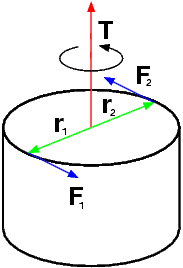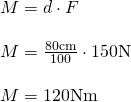Physics - Classical Mechanics - Force Couple System

[Image 1]
Introduction
Hey it's a me again @drifter1! After a quite extensive pause, where I also finally got my Computer Science Degree, I'm back to rock! Today we continue with Physics and more specifically the branch "Classical Mechanics" to continue with the chapter of Equilibrium and Elasticity. In this article we will get into Force Couple Systems that are a great example of rigid body equilibrium. So, without further ado, let's dive straight into it!
Force Couple System
A couple consists of two parallel forces. Those forces are equal in magnitude but opposite. The resultant force is zero, because the forces in a couple do not share a line of action. A couple produces only rotation and not translational movement. If the forces were unequal an unbalanced force would be produces, causing a translation of the system.The moment of a couple is equal to the product of the magnitude of one of the forces and the perpendicular distance between their lines of action:

The magnitude of the moment of a couple is equal for all points in the plane of the couple. The magnitude is independent of the reference point.
A couple cannot be put in equilibrium by a single force, but only another couple of equal magnitude and opposite direction anywhere in the same plane or in a parallel plane. Combining couples together we form a couple with a moment equal to their algebraic sum.
Example from [4]
The stem of a valve has two hand wheels. A small wheel of 30cm diameter that is used to spin the valve quickly as it is opened and closed, and a larger 80 cm wheel that may be used to free a stuck valve or seat the valve tighly when it is fully closed. Lets suppose a operator that can apply a force of 150N on each side of the large wheel. This creates a force couple. What is the moment imposed on the valve stem?Lets use scalars to solve the problem. The perpendicular distance between the two forces is equal to the diameter of the larger wheel and so 80 cm. Lets make the origin of the axes equal to the point one of the two forces is applied to. Lets also suppose an x axis that is perpendicular to both forces and passing through the point they are applied to and an y axis parallel to the forces.
That way the moment is calculated as follows:

RESOURCES:
References
- https://www.britannica.com/science/couple
- http://web.mit.edu/4.441/1_lectures/1_lecture12/1_lecture12.html
- http://www.sjsu.edu/people/steven.vukazich/docs/95.3.9%20Force-Couple%20System.pdf
- http://www.secs.oakland.edu/~latcha/EGR280/05-Moment.pdf
Images
Mathematical equations used in this article, where made using quicklatex.
Previous articles of the series
Rectlinear motion
- Velocity and acceleration in a rectlinear motion -> velocity, acceleration and averages of those
- Rectlinear motion with constant acceleration and free falling -> const acceleration motion and free fall
- Rectlinear motion with variable acceleration and velocity relativity -> integrations to calculate pos and velocity, relative velocity
- Rectlinear motion exercises -> examples and tasks in rectlinear motion
Plane motion
- Position, velocity and acceleration vectors in a plane motion -> position, velocity and acceleration in plane motion
- Projectile motion as a plane motion -> missile/bullet motion as a plane motion
- Smooth Circular motion -> smooth circular motion theory
- Plane motion exercises -> examples and tasks in plane motions
Newton's laws and Applications
- Force and Newton's first law -> force, 1st law
- Mass and Newton's second law -> mass, 2nd law
- Newton's 3rd law and mass vs weight -> mass vs weight, 3rd law, friction
- Applying Newton's Laws -> free-body diagram, point equilibrium and 2nd law applications
- Contact forces and friction -> contact force, friction
- Dynamics of Circular motion -> circular motion dynamics, applications
- Object equilibrium and 2nd law application examples -> examples of object equilibrium and 2nd law applications
- Contact force and friction examples -> exercises in force and friction
- Circular dynamic and vertical circle motion examples -> exercises in circular dynamics
- Advanced Newton law examples -> advanced (more difficult) exercises
Work and Energy
- Work and Kinetic Energy -> Definition of Work, Work by a constant and variable Force, Work and Kinetic Energy, Power, Exercises
- Conservative and Non-Conservative Forces -> Conservation of Energy, Conservative and Non-Conservative Forces and Fields, Calculations and Exercises
- Potential and Mechanical Energy -> Gravitational and Elastic Potential Energy, Conservation of Mechanical Energy, Problem Solving Strategy & Tips
- Force and Potential Energy -> Force as Energy Derivative (1-dim) and Gradient (3-dim)
- Potential Energy Diagrams -> Energy Diagram Interpretation, Steps and Example
- Internal Energy and Work -> Internal Energy, Internal Work
Momentum and Impulse
- Conservation of Momentum -> Momentum, Conservation of Momentum
- Elastic and Inelastic Collisions -> Collision, Elastic Collision, Inelastic Collision
- Collision Examples -> Various Elastic and Inelastic Collision Examples
- Impulse -> Impulse with Example
- Motion of the Center of Mass -> Center of Mass, Motion analysis with examples
- Explaining the Physics behind Rocket Propulsion -> Required Background, Rocket Propulsion Analysis
Angular Motion
- Angular motion basics -> Angular position, velocity and acceleration
- Rotation with constant angular acceleration -> Constant angular acceleration, Example
- Rotational Kinetic Energy & Moment of Inertia -> Rotational kinetic energy, Moment of Inertia
- Parallel Axis Theorem -> Parallel axis theorem with example
- Torque and Angular Acceleration -> Torque, Relation to Angular Acceleration, Example
- Rotation about a moving axis (Rolling motion) -> Fixed and moving axis rotation
- Work and Power in Angular Motion -> Work, Work-Energy Theorem, Power
- Angular Momentum -> Angular Momentum and its conservation
- Explaining the Physics behind Mechanical Gyroscopes -> What they are, History, How they work (Precession, Mathematical Analysis) Difference to Accelerometers
- Exercises around Angular motion -> Angular motion examples
Equilibrium and Elasticity
- Rigid Body Equilibrium -> Equilibrium Conditions of Rigid Bodies, Center of Gravity, Solving Equilibrium Problems
Final words | Next up
And this is actually it for today's post!Next time we will continue with Tensile Stresses and Deformations...
See ya!


Keep on drifting!
This post has been voted on by the SteemSTEM curation team and voting trail. It is elligible for support from @minnowbooster.
If you appreciate the work we are doing, then consider supporting our witness @stem.witness!
For additional information please join us on the SteemSTEM discord and to get to know the rest of the community!
Please consider using the steemstem.io app and/or including @steemstem in the list of beneficiaries of this post. This could yield a stronger support from SteemSTEM.
Hi @drifter1!
Your post was upvoted by @steem-ua, new Steem dApp, using UserAuthority for algorithmic post curation!
Your UA account score is currently 3.527 which ranks you at #6775 across all Steem accounts.
Your rank has not changed in the last three days.
In our last Algorithmic Curation Round, consisting of 97 contributions, your post is ranked at #27.
Evaluation of your UA score:
Feel free to join our @steem-ua Discord server
Hello,
Your post has been manually curated by a @stem.curate curator.
We are dedicated to supporting great content, like yours on the STEMGeeks tribe.
If you like what we are doing, please show your support as well by following our Steem Auto curation trail.
Please join us on discord.
Hi, thanks for the post! I have included the post in my daily Science and technology digest, and you'll receive a 10% share of that post's rewards.
And congratulations for completing your degree in computer science!
Thank you very much! 😊